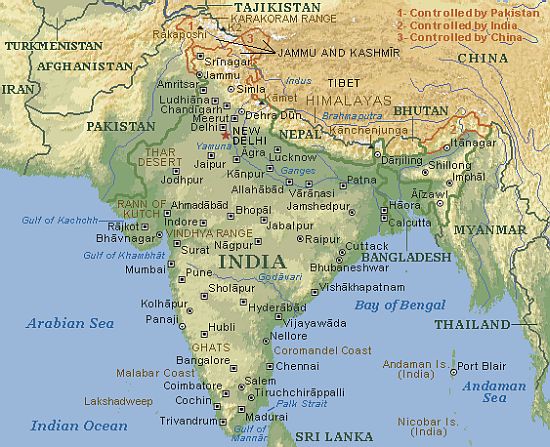
[The external boundaries of India as depicted on the map are neither correct nor authentic.]
The people who inhabited the Indus Valley region later spread to the Gangetic Plains and then to the peninsular part of India. Later migrations took them even beyond to Sri Lanka, Indonesia, the Southeast Asian countries, and so on.
They founded numerous kingdoms identified by the dynasties in different parts of the subcontinent. Each of these kingdoms had their own names.
It is the medieval foreign travelers, later invaders and immigrants, who felt the need for a single name that would collectively refer to all kingdoms and peoples of the subcontinent. They took the Persian term “India” from the ancient writings of the Hebrews, Greeks, etc. – where it had been used to refer to the Indus Valley region – and began using it to refer to the entire subcontinent that now consisted of hundreds of kingdoms with peoples of so many different languages and cultures.
This is how the name “India” began to be used to refer to the whole of the subcontinent. The Mughals called the country Hindustan, a name derived from Indus or Sindhu.
The rulers of the British Empire followed suite; and one of the two modern nations that took birth on the departure of the British from the subcontinent chose to retain the name “India” as it meant some sort of historical continuity for them, and the name (politically) ceased to refer to the regions which it originally referred to in the ancient times. The other country, which actually consisted of most of the lands of the Indus Valley civilization, coined a new name for itself in “Pakistan”.
But (this is an important “but”), a large section of the people presently inhabiting the Indus Valley region and the nearby areas (Sindh, Punjab, NWFP, Balochistan, Kashmir, and parts of Gujarat and Rajasthan) are descendants of later migrant groups to the region (like the Arabs, Greeks, Central Asians, and so on), though a considerable percentage of these later migrants have also followed the earlier Indus people in moving eastward and coming to live in other parts of the subcontinent.
Some of the nomadic mountain tribes living in parts of present day Pakistan may have a better claim to the name “India”, than many of the advanced modern communities in that country (who are mostly made up of later Persian, Arab, and Central Asian immigrants).
A large percentage of the population of the political entity now called “India” consists of descendants of the people who inhabited the Indus Valley region during the heyday of the Indus civilization. Thus, the descendants of the people of the Indus civilization are now spread all over the subcontinent and are more concentrated in the central and southern parts of it.
Mahabharata is essentially a story that relates the spread of a section of the Indus people to the Gangetic plains. The division of provinces subsequent to the chess game played between the main characters opens up the story of the eastward spread, with the defeated party getting the forested and undeveloped regions to the east of the river Yamuna allocated as its portion. The winners had the right to retain the already settled and inhabited regions to the west of the river. The main events of the story took place in locations in Afghanistan and Punjab (Gandhar, present day Khandahar in Afghanistan; Takshaseela, present day Taxila in Punjab; and Kurushetra, the epic battle field, is in present day Haryana). Therefore geographically it is Pakistan that can claim the name “Bharat”!
(What began as a Comment to Hassan Rizvi’s article “A Himalayan Blunder – The Misnaming Of India!” grew too big and I thought it merited to be a separate article.)
Image source



